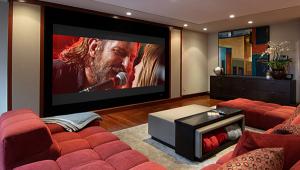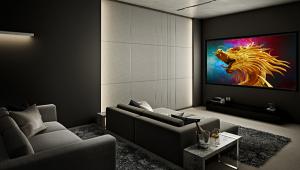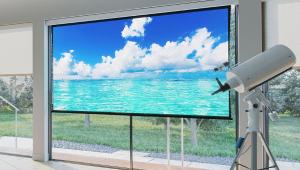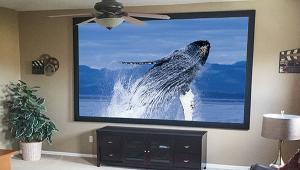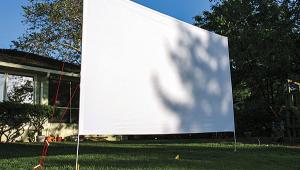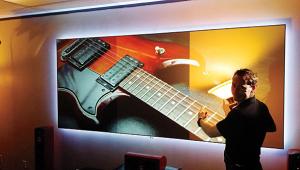Sony VPL-VW665ES 3D SXRD 4K Projector Review Page 2
Sony’s Cinema Black mode, which controls the dynamic iris, wasn’t quite as impressive as what I remembered from the VPL-VW600ES. While I did see some improved performance in the measured contrast numbers, I also noticed the dynamic iris more in everyday viewing, including image pumping. It wasn’t overly distracting, but in the past the Limited mode I used for Sony’s iris was nearly imperceptible in normal viewing. And the dynamic iris mode is a must, due to the rather low native contrast performance of the SXRD panels (in this case, about 6,000:1 native contrast), if you want the best contrast performance (nearly 70,000:1 dynamic!) from the image. The dynamic Full mode didn’t offer any additional contrast performance and was too aggressive in its changes, resulting in even more obvious operation in darker material and fade-in and -outs.
 Overall contrast performance was solid, though. The Sony doesn’t quite compete with my reference JVC DLA-X700R projector when handling the darkest material out there, but the super-bright, punchy image delivered fantastic visuals, with deep blacks and solid dimensionality. The Sony also doesn’t suffer from the black uniformity issues we’ve seen from JVC models with full blackouts. I hope we’ll see Sony continue to refine their SXRD panels to allow for higher native contrast numbers. This would reduce the need to be as aggressive with their dynamic system and eliminate some of that visible pumping in the image.
Overall contrast performance was solid, though. The Sony doesn’t quite compete with my reference JVC DLA-X700R projector when handling the darkest material out there, but the super-bright, punchy image delivered fantastic visuals, with deep blacks and solid dimensionality. The Sony also doesn’t suffer from the black uniformity issues we’ve seen from JVC models with full blackouts. I hope we’ll see Sony continue to refine their SXRD panels to allow for higher native contrast numbers. This would reduce the need to be as aggressive with their dynamic system and eliminate some of that visible pumping in the image.
I watched a multitude of 1080p content during my time with the Sony VPL-VW665ES. This ranged from streaming TV shows to the latest Blu-ray releases. While I could nitpick a lot on the projector’s performance with test patterns, it looked sublime with real content. The high light output of the Sony in low lamp mode delivered a captivating 22 foot-lamberts on my screen after calibration, which is a bit higher than I usually watch. But getting it down to my typical brightness (14 ft-L) would have compromised the contrast performance, so I stuck it out. I must say, it was a fun ride. Fine object detail jumped out more than I’m used to, and the colors looked incredibly rich and vibrant. I can certainly understand why people enjoy a brighter image, though some quick transitions from dark to bright in some content caused a few moans and groans from both me and other viewers from time to time.
The best images were served up from the latest Blu-ray offerings. I had a chance to look at some great ones, including Disney’s recent Tomorrowland, which boasts one of the most detailed 1080p images I’ve ever seen. If you want to see how good 1080p can still look, this is one to watch; it makes a strong case against moving to 4K! I also had a few of Sony’s own Mastered in 4K titles on 1080p Blu-ray. The VPLVW665ES’s Reality Creation controls offer a Mastered in 4K mode that is said to take advantage of these titles. Unfortunately, the results weren’t good. Engaging this mode with these titles produced a considerably softer image that didn’t even compare with the standard Reality Creation mode I had already dialed in. This setting should be avoided, even with the Sony content made to be played on it.
Another eye popper was Pixar’s recent release of Inside Out. The brighter picture levels lent a lot to the razor-sharp image and vivid colors. I viewed this one in both 2D and 3D and loved every minute of it. Incidentally, 3D performance with the new Sony seemed about the same as last time around from the VPL-VW600ES, with only some minor ghosting noticed on the most difficult material. The built-in RF emitter made setup a breeze, and the higher light output of the Sony made 3D images nice and bright (though I’m not the biggest fan of Sony’s glasses). If you’re a fan of 3D, you’ll have little to complain about overall, though we’re still seeing the performance of LCOS projectors fall short of the perfect 3D performance of DLP-based projectors.
UHD
While I’ve reviewed native 4K projectors before, and a few other projectors that support 4K content, this is the first review where I actually had a pretty large amount of 4K content at my disposal. Previously, I was limited to demo clips that are similar to the slow-moving, ultra-sharp content you see in store demos. While these look pretty, they don’t give a fair representation of what real 4K content usually looks like with TV shows and movies.
Sony provided me with their latest 4K Ultra HD media player and supplied some test clips like those I had before, as well as a pair of clips mastered in HDR. I also picked up one of the new Roku 4 media players that offered a large selection of 4K sources, including M-Go, Netflix, Amazon, and Vudu. The quality of the clips from the streaming services varied a bit. Compared with their 1080p Blu-ray counterparts, images showed a visible improvement in over-all detail, but they also took a step back in compression quality, with visible artifacts creeping in from time to time, especially in darker images. But even with these limitations, it was clear that the added resolution benefitted my larger screen, with crisper detail in both foreground and background imagery. Netflix offers a large number of their original programs in 4K, and if you’re looking for strong detail, this is where you’ll find it. Their popular House of Cards was probably the highlight, followed by The Blacklist. Both had impeccable detail and depth that really showcased what gains you can expect from 4K.
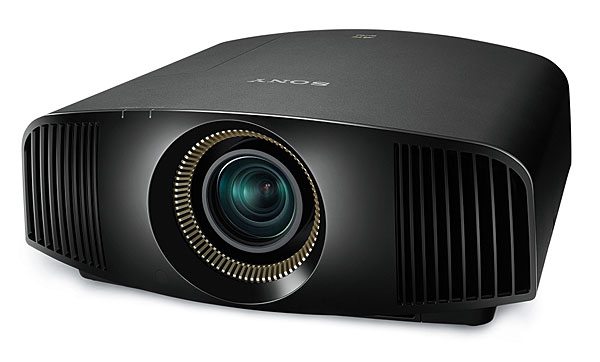
For movies, I turned mostly to Vudu, which offers UHD streaming via the Roku 4. I had the chance to look at a couple of Warner’s latest UHD offerings, including Edge of Tomorrow, Man of Steel, Magic Mike XXL, and The Lego Movie. Unfortunately, like most films being advertised as 4K, nearly all of my selections weren’t from true 4K masters (only Magic Mike XXL made the grade), yet they still looked more resolved than their Blu-ray counterparts. Edge of Tomorrow was a standout, with great fine object detail that delivered a sharper image than the Blu-ray.
One of the key features introduced with the VPL-VW665ES is support for HDR, or high dynamic range. HDR is still a bit of a minefield to navigate, with competing formats battling it out for adoption, but the Sony includes support for the HDR10 “open” SMPTE standard that was adopted for Ultra HD Blu-ray. I could go on and on about the mess that is HDR today and the wild-west nature of the development of this new feature. But let’s just say that, right now, there’s little to no benefit offered by HDR to projectors. They simply don’t have enough light output to take real advantage of the content, whether we’re talking about specular highlights or increased color luminance. Ultimately, the only advantage here is that the Sony recognizes and supports HDR at all, though in an uncertain manner since there’s no clear standard in place (as of the end of December 2015) for calibration or proper playback. Sony’s HDR mode did look pretty good with the HDR clips provided, though, with nice contrast and bold color saturation from the P3-mastered clips. But this isn’t a selling point that I would concentrate on until the dust settles on HDR and better standards and practices are in place.
Conclusion
Despite some quibbles, I can still say that the VPL-VW665ES delivers some of the best images I’ve ever seen in front projection. Whether with 1080p or native 4K, overall performance was stunning. But there’s room for improvement. It doesn’t offer the future-proofing one might want in these early stages of UHD, and I hope to see Sony continue to refine this projector in future models. And my sample’s lack of perfect focus uniformity was troubling, to say the least. Still, once the movie starts, you’ll find it hard to fault the image on the screen, especially with the content available on the market today and in the near future. If your budget can support it, this is one to consider when you’re looking at the best of what projection can offer for today’s best content.

